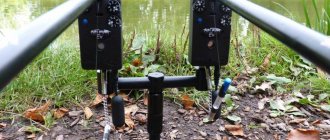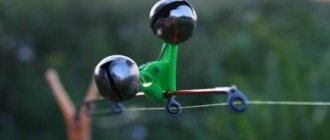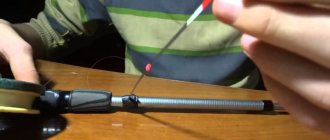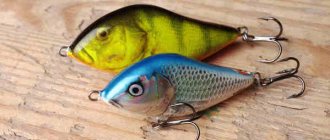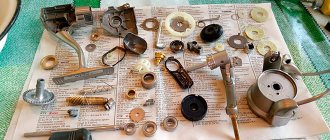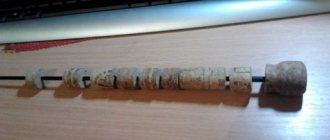Bite alarms are a real carp fishing float, which is responsible for indicating a bite and makes the only noise that brings joy to our hearts rather than irritation. The meaning of the alarm for carp fishing is that the fishing line is placed in a special roller. When a fish bites, the line begins to slide along the roller, causing it to spin, and from this rotation the alarm emits a sound signal. The faster the rotation, the more often the siren sounds. That’s why the term “locomotive” appeared - when the fishing line quickly runs along the roller and it squeals incessantly.
The electronic alarm is usually powered by a battery, usually a crown, AA or AAA, depending on the specific model. It has the ability to adjust the signal volume, and on advanced versions even the pitch and sensitivity. This is done so that by the sound you can determine which rod you need to hook. This is especially true in the dark.
However, one electronic alarm will not be enough. The fact is that the electronic alarm itself works well if the fish pulls the line from the shore, thereby giving it tension. If the carp bites towards the shore, then the line will sag and will not put any pressure on the roller at all. Accordingly, he will remain silent.
It is for such situations that mechanical alarms are used in combination with electronic ones. They are also convenient for adjusting the tension of the fishing line. Mechanical alarms are a real weight that hangs on a fishing line. At one end you get a sinker that you throw into the water, and at the other end there is a mechanical alarm. By winding the fishing line with a reel, you tighten the tackle; by releasing the fishing line, you loosen it. We will talk about the tension of the fishing line and how it affects the bite later.
Electronic signaling devices have a standard thread that fits any rack. For greater convenience, so as not to screw every time, you can purchase a special quick release. This is a two-part piece. You screw one into the rack, the other attaches to the alarm. And then you simply insert the one with the signaling device into the one that is screwed into the rack.
The mechanical signaling device is equipped with a special insert through which the electronic thread passes. You put the mechanical alarm on the thread of the electronic one, and screw the latter into the rack. Thus pressing the fasteners of the mechanical signaling device. It needs to be positioned so that it is parallel to the rod. After you have cast and placed the rod on the electronic indicator, you attach the mechanical one to the fishing line and begin to adjust the tension. After completely setting up the gear, turn on the electronic alarm. This will help you avoid unnecessary "peaks" that are completely useless. According to the unspoken etiquette of carp fishing, only the fish can make the alarms squeak, but not the angler.
Therefore, if you need to recast, turn off the alarms, and only then raise the rod. Of course, if there was a bite, we turn off the alarm before we put the rods back on the racks.
Pager. An excellent invention in which you can completely turn off the sound on the alarms and be guided only by the sound of the pager. Picks up a signal at a distance (on average about 100 meters, it all depends on the model). After simple manipulations, you connect the alarms to the pager and that’s it - you can sit quietly even in a closed tent, wait out the bad weather and drink hot tea. You also don’t have to worry that you won’t hear the alarms in your sleep – a pager is the best alarm clock, believe us!
How many alarms will I need?
Each working rod is a set of electronic and mechanical signaling devices. We strongly recommend that you don't try to get by with just one thing. We hope that we are writing this in vain and no one will think of fishing only with an electronic or only a mechanical one, but just in case - if you put only an electronic one, then when you bite “on the bank”, you can forget about the signal and timely hooking.
It simply won’t be there - the line will weaken, fall through and you will have to first reel in the slack and only then hook it. By this time, the fish will probably have gone into cover and a break will occur. If you install only a mechanical alarm, then you will have to turn into an owl for three days and stare at the fishing rods without stopping.
How to make a bite alarm for a feeder?
Fishing with a feeder is gaining more and more supporters who are not inclined to the active method of fishing with spinning or fly fishing. However, purchased branded tackle rarely corresponds to the owner’s wishes at least to some extent.
The desire to make the fishing process more comfortable leads to attempts to bring the feeder to perfection. And one of the directions of this search for the ideal is to make the moment of the bite simple and clear.
In fact, every extra cast is not only an inevitable overconsumption of bait, but also emotional disappointment and annoyance. Therefore, the first step that a discerning feeder takes on this path is to pay close attention to the bite alarm.
Eye Alarms
In the “standard configuration” of the tackle, the bite is visible by the bend of the tip - the thinnest part of the rod.
You can argue as much as you like about the sensitivity and practicality of the “native” alarm, but the facts, nevertheless, are as follows:
- to constantly be in intense attention without taking your eyes off the feeder is beyond the power of even the most ardent fishing enthusiast
- The sensitivity of the tip depends on many factors - rod length, material, quality. If the rod is too stiff, a slight touch of the bait by the fish may go completely unnoticed.
- you can use not one tackle, but 2-3, sometimes more, sometimes at a considerable distance from each other
The most common designs include:
- float
- nod
- foil tube
Operating principle
Alarms operate in the following way: using various devices, which include beacons, fireflies, and nods.
They help make the biting process more noticeable, more obvious and help you stop doubting whether you are biting or not, and prevent unnecessary empty attempts to cast the tackle. This helps a lot in saving effort, time, and bait. And it needs to be updated every time you cast it.
Manufacturing instructions
You can take a regular factory-made float or cut it yourself from a piece of dense foam. It is preferable to make it yourself, since it is easier to select the “buoyancy” parameters of the float for your gear.
To do this you need:
- Cut a ball with a diameter of 6-7 mm from a piece of foam plastic
- paint the top red or orange, bottom blue
- make a hole in the center of the ball
- insert a beech rod into it, its thickness is up to 2 mm, length 6-7 mm
- paint the upper half of the rod with stripes of different colors
- put a figure eight on the bottom
- secure the fishing line
- Hang weights just above the hook (they will load half a ball of polystyrene foam into the water)
Painting the foam ball should be done after it has been treated with epoxy resin or varnish to reduce its porosity.
Nod
In essence, the nod is a continuation of the tip of the feeder, but more sensitive to the tension of the fishing line when biting.
The nod, made of spring material, is more sensitive than the feeder tip, it reacts to the most careful bites, making them more noticeable.
For their manufacture, mainly thin plastic and metal plates are used.
The nods are attached to the tip of the rod. For summer fishing, the nod should be oriented at a 90-degree angle to the rod to improve visibility.
Manufacturing instructions:
- You need to choose a suitable material - rigid springy steel wire or part of a ribbon spring . Ideally, a spring from the clock mechanism of an old alarm clock. By experimenting with different clocks, you can get a set of nods of different hardness, and, consequently, sensitivity.
- It is preferable to construct the attachment to the top from a polymer or rubber tube. This way you will get a strong mount that will not fly off the tip when casting.
- By extending the spring from the tube to a greater or lesser length, you can adjust the rigidity of the nod “in the process.”
- A spring or wire is taken 15–20 cm long. A ring is made at the free end to allow the scaffold to pass through. You should make sure that the tackle moves freely through the nod ring, otherwise the line may break during casting, the feeder will be shot, and in the worst case, damage to the tip of the feeder
Simple sound alarms
The devices listed so far can make life easier for a fisherman only if fishing is carried out with one tackle.
Typically, anglers make several casts from 2-3 or more feeders at once.
In this case, the likelihood that a bite will be immediately noticed, even when using visual “amplifiers,” is again sharply reduced.
In this case, signaling devices that attract attention by emitting a sound signal - different bells - will be able to do so.
They are attached to the rod differently. They are best used with bottom gear, both during the day and at night.
Side bite alarm for feeder
It is preferable to use a side bite alarm in strong winds and during waves when fishing with bottom gear. Many fishermen have experienced the effectiveness and sensitivity of its signal in difficult tinning conditions on their feeders.
Device
This is a mechanical spring device, fixed at one end to the fishing rod, which distinguishes it from other mechanical counterparts. At the free end, the spring arch has a hook curved in the shape of the Latin letter “Z”, onto which the line is thrown after casting.
When bitten, such a signaling device attracts attention by energetic “nods” of the free end towards the rod.
The indisputable advantage of such a signaling device is its insensitivity to gusts of wind and waves.
Manufacturing
To make it you need:
- select a spring steel wire of at least 20 cm
- give it an arched shape
- secure the opposite end of the arc in a 10-15 centimeter piece of a thin metal tube. To do this, insert the end of the arc into the hole drilled in the tube and bend it 90 degrees, ensuring a secure fit of the wire to the surface of the tube.
- For connection, you can use any of the universal “instant” adhesives.
- tightly wrap the joint along the entire length with a harsh thread and coat with glue
- To attach the device directly to the rod, it is convenient to use a fastening clamp for plastic pipes
- the tube is inserted into the hole drilled in the clamp so that it is parallel to the rod
- the tube should rotate in the hole with some effort
The clamp is put directly on the rod and after casting the line is thrown over the hook of the spring arch.
The bite pulls on the tackle and the alarm bends down to the feeder.
This nuance allows, by modifying the design with the above-mentioned reed switch attached to the fishing rod, to obtain a universal combined signaling device - sound, mechanical, and when the electronic circuit is supplemented with an LED - also light.
Naturally, you should take care to brightly color the spring for a better visual effect.
Electronic bite alarms
This is an electronic analogue of a bell. The simplest version of such a “squeaker” is the filling of any toy with a button, when pressed it produces a sound - a tone signal or a melody. The button in such toys simply serves to close two contact plates.
Scheme
One of the simplest schemes using a sensor on the RPU-2 relay, you can use any of its analogues. The fishing line is inserted behind the sensor, and the connector is closed manually.
When the line is pulled during a bite, the line will pass through the sensor and a signal will sound from the speaker due to the sensor being triggered. If desired, you can install an LED, and there will also be a light alarm.
Prices for alarms
Electronic signaling devices. So, alarms, like fishing rods, are divided into three budget segments. Budget models are, as a rule, the simplest alarms, in which there is only one setting - the volume of the signal. Sometimes you can’t even connect a pager to them. But they are really inexpensive. The best option for beginners is definitely the FOX Mini Micron. It is quite inexpensive, yet it is completely sealed and can withstand any rain or cold.
You can also purchase a set of alarms with a pager. If your rods are located far away, a pager is very useful in such situations. If you go to the same body of water and always stay near the drains, then you can do without a pager. Here the choice is yours.
Also in the segment of budget signaling devices, the JRC RADAR CX Multicolor model deserves close attention. Although they are in the mid-priced range, the alarms have undergone a full cycle of preliminary testing in the UK. This is a complete set of bite indicators for modern carp fishing!
If we continue the conversation about available alarms, then it is simply impossible not to mention the model from Carp Spirit “Blax Alarm“. A real workhorse at a very affordable price. This is a real find for amateurs and beginners!
One of the latest innovations that the carp equipment market offers is the FOX RX+ alarms. They replaced the top-of-the-line NTXr+ and introduced the world to a much wider range of capabilities. Incredible sensitivity, which literally reacts to the movement of the fishing line in a matter of millimeters, while you can also set a much less sensitive mode. The pager has a “night mode” that will respond to all bites, but will not disturb the angler’s sleep over trifles.
Mechanical alarms. Everything is simple here. The world of mechanical signaling devices has changed since the release of the FOX Black Label Bobin. This series is a real constructor that allows you to instantly adapt to wind, zig-rig, long and short fishing distances without any extra effort. Read the full review here. We talk in detail about the advantages of this series and the rules for using all components.
The Korda company has also prepared a very interesting model. They offered anglers universal signaling devices that are suitable for fishing close to the shore, with a weakened fishing line. At the same time, if you put a heavy sinker, then it is quite possible to fish at long ranges, but it is their work at “amateur” distances that makes them so popular among amateur fishermen.
Subsequently, FOX introduced an updated line of mechanical alarms, adding the Dumpy Bobbin and Stealth Bobbin models. We also wrote a long and detailed review about them.
In general, mechanical alarms are divided into “swingers” and “bats”. Bats are two balls, between which a fishing line with a chain clings. Swingers are a metal leg and a special lock that hangs on a fishing line. Bats are more delicate, but are subject to strong fluctuations during the wind. Swingers are heavier and put more tension on the line. Therefore, previously it was necessary to have both types of alarms in the arsenal in order to adjust the gear to certain conditions at the right time. With the release of Black Label this went away.
Portable electronic alarms
Naturally, the functionality of portable devices is very limited, although they are inexpensive and do not take up much space. For night fishing, you can offer the “Strike Alert” model at an affordable price. The body of the device has special grooves, which allows you to quickly and effortlessly attach the alarm to the tip of the fishing rod.
In standby mode, the indicator lights up green, but when a fish is hooked, the indicator lights up red. The bite is determined by the intensity of vibration of the rod. In addition, the alarm ignores the strength of the wind and the presence of waves. If the wind is strong, false alarms are possible.
It is worth paying attention to the Russian development “Megatex” Jay 3. The alarm can be used for fishing at any time of the day. The device has 5 levels of sensitivity control. In fishing conditions, when there is no current or wind, the most sensitive levels are used, and in conditions of wind and current, levels 2 and 3 are used. The device has a function for adjusting the sound strength and changing the tone. All functions are selected using one button. When you press the button, the device turns on, and if you press the button again, it turns off.
If you press and hold the button, the device begins to emit characteristic signals (begins to beep). Each sensitivity level is set after the next signal. The nature of the sound signal can be changed on the seventh, eighth and ninth signal.
To disable all functions, just wait for the 10th signal. To change the tone, you need to hold the button for about 20 seconds, after which the device begins to cycle through and play melodies. To select the melody you like, just release the button. On the one hand, this is a modern, advanced device, but on the other hand, it is not entirely practical, due to the fact that all modes have to be selected with one button.
Selection of alarms
Of course, first of all, you should start from your budget. The best option is to buy alarms as a set. This way they will be much cheaper than purchasing four alarms and a separate pager separately. Currently, in stores you can always purchase “3+1” (3 alarms and 1 pager) or “4+1” (4 alarms and 1 pager) sets. All sets are supplied in protective cases, which is also a big plus - it’s convenient to store them after fishing.
The same applies to mechanical alarms, although they are much cheaper than electronic ones, and this is quite logical.
Based on companies, we would recommend the FOX Mini Micron series for beginners. You can save a lot on a pager, but if you can buy one, that’s great. We have used different models from FOX and can confidently say that these are top quality products, which, in principle, solve the problem of choosing alarms forever.
Light signaling devices (firefly)
For night fishing, one of the most common types of signaling devices is “fireflies”.
They are easy to use, affordable and suitable for all types of fishing (bottom, float or spinning). Basically, signaling devices produced by the manufacturer have the following forms:
- In the form of a nail or stick;
- In the form of a light bulb, which increases the lighting area.
According to the principle of operation, such devices are divided into three types:
- Collapsible capsules with small batteries and LED. These fireflies are reusable, thanks to the replacement of batteries.
- Light accumulative signaling devices. The principle of their operation is the accumulation of light during short-term illumination. For them to work you need to have a good flashlight.
- Disposable chemical fireflies. They consist of a plastic flask with component A. Inside of which there is a capsule with reagent B. Under mechanical action, components A and B are mixed, and a reaction occurs - glow.
Signal lights can be of different colors. For chemical species, the most popular is a yellow-green glow. It's a pretty bright color. It is calm enough not to irritate the eyes. There are also light and sound bite alarms. They will be discussed below.
Fireflies are attached:
- On a float, inserted into their silicone antennas. Or use rubber bands to place them on the tops.
- To the tip of the rod, using silicone rubber bands. Special plastic fasteners are also sold. Several fireflies can be installed in such mounts.
The main brands that can be bought at a fishing store: Ocean Sun, Kostal, Balzer, Salmo, Rodinson, Liman Fish, Strike Alert.
Do-it-yourself light signaling device
As mentioned above, light signaling devices have proven themselves well when fishing at night. Regardless of whether you buy them in a store, you can easily make such an indicator at home. To make it you will need:
- Cocktail straws;
- Crocodile clips;
- Glue gun;
- LEDs;
- 3 V coin cell batteries;
- Heat shrink, according to the size of the battery.
A piece of straw 3–4 cm long is filled with a glue gun. An LED is inserted inside. Its legs protrude by 0.5 cm. A battery is inserted into a heat-shrink tube, 2 cm long. A piece of straw with a pin attached is inserted into one end of the heat shrink. It shrinks tightly using a lighter. A straw with an LED is inserted into the second end. The LED legs are located on different sides of the battery (+, -). It fits so that it can be pulled out.
This homemade device is enough for the entire fishing season. Manufacturing does not take much time, does not require soldering or high costs.
How to configure alarms correctly?
The logic is as follows. The further the fishing distance, the stronger the line tension. The closer the fishing distance, the weaker the line tension. When fishing with a zig-rig, a strong line tension is required.
In general, regarding the dependence of line tension (setting up alarms), there is a wonderful guide from Rob Hughes, which has been tested for years, and from which you can safely build on.
- Fishing near the shore, at any depth - low tension
- Fishing at medium distance (up to 60m-90m), at any depth - medium tension
- Long-distance fishing, as well as fishing at any distance with obstacles (grass, algae) - strong tension
Below are pictures, from left to right: medium and high tension. The pictures are guidelines rather than strict illustrations. There is no need to measure the height of the signaling devices on them down to the centimeter. This is rather just a demonstration so that you have something to start from. With a weak tension, the mechanical signaling devices are strongly lowered down to the ground.
Why do you need to vary the line tension? If you are fishing at a long distance, then slack line can prevent the alarm from detecting a bite, since it neutralizes the movement of the line. Roughly speaking, not the whole line will move, but only some part of it. When fishing close, on a shorter piece of fishing line, medium tension is quite enough. Moreover, near the shore, a fishing line stretched like a string will scare away the fish.
Sound alarms
This category of alarms includes various devices that signal a bite with sound. Their design is quite simple and are:
- Bells on a clothespin;
- Rattles;
- Bells.
Such indicators are used on bottom gear at night. Sound alarms are also installed during daylight hours, when it is difficult to visually monitor a large number of gear. They are usually mounted on a fishing line or the tip of a donkey rod. (Pictures enlarge.)
Classic bell pendant
Bells pendant
Signaling bells from the company Salmo
Very often, the factory fastening of the bell is difficult to remove during hooking from the fishing line. This interferes with the normal rewinding of the tackle when fishing. Therefore, you can modify the alarm holder yourself. For this you will need:
- Thin-walled rubber hose, approximately 3 cm in diameter.
- A small bolt with a nut that will go into the bell ear
A ring 1.5 cm wide is cut from the hose. An incision is made on the ring and shaped into a hook. You need to make a hole in its long part. Through it, the bell is attached to the elastic band using a bolt.
You can make the bell yourself. For example, from decorations on the backs of old iron beds. They look like a cylinder with conical tips.
For production you will need:
- Saw the cylinder in half;
- Make a hole in the top;
- Attach a nut to the self-tapping screw, tying it to a fishing line. This will be the tongue of the bell;
- Self-tapping screw, screwed into the hole from the inside of the bell;
- A wine cork is placed on the tip. An incision is made in the cork to attach the indicator to the fishing line of the fishing rod.
You can make a bell from an old telephone bell. We analyze the call, we get two cups. In the upper part, through the hole, a tongue is fixed. You can use a nut on a fishing line for it. To install the alarm on the fishing line, you can use a cork.
Hand-made bells differ from factory-made ones in their special sound. This allows you not to confuse their sound while fishing with their neighbors.
Transportation and storage of alarms
If you buy alarms as a set, you will receive a convenient storage case for free. If you buy alarms separately, then you should think about where you will store them. An alternative is to leave them on the buzz bars and put them in the buzz bar storage bag. There is also a pocket for mechanical alarms. It is better to take good care of this, because the protective case in which the alarms are sold can rather be regarded as external protection. Under serious loads, it is unlikely to save.
DIY feeder bite alarm: video, electronic, bell, float, nod
At its core, a feeder is a modern bottom tackle, using feeder feeders and a rod with a sensitive tip. This type of fishing can be called universal, since it is suitable for all types of reservoirs and can be used when catching almost any fish common in our latitudes.
Features of fishing with a feeder
The presented type of fishing can be mastered by any novice fisherman. In addition, this activity does not require large financial investments, which is important in our time. With equal success, you can catch both predatory fish and other species using the feeder.
To intensify the process, experienced feeders often throw in complementary foods and set up several gears. This type of fishing allows you to make long casts and catch at close range. By choosing the right position and distance, you can throw over any thickets, reeds and snags.
For the optimal choice of gear when fishing on a feeder, the following factors must be taken into account:
- features of the reservoir (current, depth, rocky shore);
- carrying out the process from the shore or floating craft;
- size of fish expected to be caught;
- time of day and time of year (these factors influence the choice of casting range).
Definition of a bite alarm and its purpose
Bite alarms are used to provide timely notification that a bite has been detected. They come in several types and differ in signal output, but have the same principle of operation. It consists in the fact that the fish, having swallowed the bait, moves, tightening or loosening the fishing line. It is to these maneuvers that the alarm reacts, informing the fisherman that it is time to take measures to reel in the catch.
Alarms are divided into several types:
- Mechanical . They are performed in the form of a sensitive rod tip or by installing a certain weight on a slack line between the first input ring and the reel. Tension or sagging of the fishing line, which alternate periodically, signals that there is a bite.
- Swinger. A type of mechanical beacon, the essence of which is as follows:
- plastic head with a fishing line clamp, attached near the first ring;
- a kind of lever is mounted on the opposite side of the clamp to secure the load;
- the second side of the lever interacts with the bracket, which is mounted on the fishing rod;
- the fishing line is inserted into the clamp and signals changes in tension by moving the weight along the lever.
- Electromechanical . These are the so-called “tweeters”. Their principle of operation is that when the fishing line is activated and vibrates, the device emits a sound and light signal, which is very convenient both for night fishing and just for a kind of rest when you have to be distracted.
All types of signaling devices presented can be built with your own hands. This process will not take much time, money and effort, but will save some money compared to factory-made analogues.
Do-it-yourself visual alarms
To detect a bite by visual assessment, which is used by most fishermen, it is necessary to build an eye alarm. The following items are mainly used for these purposes:
- float;
- rod tip;
- additional beacon on the fishing line and rod;
- firefly type beacon for night fishing.
Let's consider the presented options in order.
Float
This option is recognized as elementary, for the creation of which the following items are suitable:
- cork or foam;
- goose feather or any other large bird;
- a branch of a bush or low-growing tree.
A float and a cork are more preferable in reservoirs with a strong current when fishing for pike, perch, carp, which pay little attention to the disturbances of the float when biting. Feather alarms and twig floats can be made in minutes using a knife. Catching crucian carp, roach, and bream is quite possible with their use. They are attached to the fishing line using an elastic band or cambric.
Rod tip (nod)
Experienced fishermen determine when a fish is biting by the tip of the rod. But a standard change in the tip is not always able to fully inform about the bite due to the low sensitivity of the rod tip. Homemade nods, which can signal a bite from less active prey, will help correct the situation.
Homemade nods made from springy metal wire or plate are very successful. The nod is attached by fixing it to the top of the rod using adhesive tape and passing the fishing line through the provided groove.
Artisanal nods are very effective when catching cautious fish, jig fishing, and bottom fishing in determining the accurate bite of bream. In order for the slightest change in the nod to be noticeable, it can be fixed on the side of the rod tip.
Firefly
For those who like to fish at night, a firefly-type alarm will come in handy. This system consists of a soft polymer tube, which is attached to the edge of the rod, and a luminous indicator is inserted on the back side, which, for full use, should be shaken and broken in several places.
If the tube and the fastening of the luminous element are incompatible, you can use transparent adhesive tape to fix it. For repeated use of the firefly, experts recommend storing it in the freezer after fishing. Consequently, the chemical reaction slows down, and the alarm can sound several more times.
Foil tube
One of the simplest bite alarm devices. It is a piece of foil rolled into a tube. This homemade unit is fixed to the fishing line, and if its tension changes, it changes position.
In addition to the fact that the reflections of the foil are noticeable in the dark, it also makes a peculiar rustling sound, which additionally indicates the possibility of successful fishing.
The downside is its high windage, which makes use in windy weather problematic. To stabilize the beacon, a fixing pin is used. Having a large mass, it holds the signaling device in a uniform position.
Simple do-it-yourself sound bite alarms
Elementary sound bite alarms are devices using bells. The point is that the bells have different tones and vibrations. They can indicate to a fisherman with an ear for music which fishing rod worked and the weight of the expected catch.
The simplest bells can be made from the remains of a metal pipe, with a tongue made of a bolt, washer or nut placed inside. The most optimal way to attach this device is a regular clothespin.
The right bell
The signaling device with such an original name is a standard bell, but has a unique method of mounting and fixing on the feeder. There are several types of methods for attaching the correct bell:
- fixation on the feeder using any household clamp (simple and effective method);
- It is more reliable to attach the bell by connecting a hook made of wire and jute. The device is mounted at a distance of about 200 mm from the top of the rod. A bell is attached to the harness, which after casting should be a few centimeters away from the maximum line tension;
- Next, you should adjust the position of the fishing line and observe its changes and the reaction of the bell after each cast.
DIY side bite alarm for feeder
The side beacon is a device identical to the nod. Its main components:
- metal or plastic elements;
- similar method of attachment to the feeder;
- installation between the first ring and the coil.
The length of the working part of the side alarm is 100-150 mm, and opposite the feeder there is a hook into which the fishing line is placed after casting. The mounting angle of the alarm is 90 degrees relative to the feeder form. When the line is pulled, it lies parallel to the feeder.
To make a side signaling device, you will need the following parts:
- metal tube , length 50 mm and cross section 3 mm;
- spring wire about 200 mm long;
- is bent from one edge , then secured in the prepared tube by making a Z-shaped hook with bends of 10 mm;
- After installing the device on the feeder, inserted into the alarm hook is cast and adjusted
Attention should be paid to the material of manufacture, since elements that are too hard can make the alarm insensitive. It is reasonable to attach a bright beacon at the end of the hook to make the device more informative.
Electronic options
The presented samples have an operating principle based on closing and opening an electrical circuit. Making the simplest version:
- We take as a basis an ordinary keychain with a melody;
- it is attached to the feeder stand, and the contacts are in the closed position;
- they are brought out in the form of 2 plates;
- A plastic fragment 1 mm thick is fixed between the coil and the first ring, and the second end is inserted between the removed contacts.
As a result, the bite closes the contacts and a certain melody sounds.
Sensitive hands
Alternatively, you can use your own body as a bite alarm. In this case, you should pass part of the fishing line through your hands, and with the slightest tension, you can instantly make a hook. However, this method requires patience and concentration, since even swatting away mosquitoes will be problematic.
Having chosen this method of fishing, you should choose a comfortable position and have a stable nervous system. In any case, ingenuity and ingenuity will only benefit a fisherman of any rank.
Bottom line
Regardless of what type of alarm you choose for feeder fishing, it is worth remembering the main purpose of the auxiliary devices. They should help and facilitate a successful quiet hunt and in no case become an additional headache.
That is, if you have a proven method that you have been using for years, you should think about whether it should be radically changed to a new one?
Experiments are, of course, a good thing, but it’s worth remembering the proverb that a bird in the hand is more reliable than a pie in the sky.
Source: https://poklevok.net/dev/signalizotor/na-fider-svoimi-rukami.html
Pendulum type
The head part is painted in a bright color to facilitate visual contact at the time of the bite. Usually the weight of the load on “swingers” is no more than one hundred grams.
This alarm works according to the following principle:
- After casting the feeder, the fishing line is tucked into the clamp.
- The tension of the fishing line is regulated by a sliding weight.
- At the moment of a bite, the head of the “swinger” begins to move, thereby signaling the angler to start biting.
It is very important to correctly adjust the tension of the fishing line; it should be such that a “golden mean” is formed between the tension of the fishing line and the moment of its sagging, that is, the minimum. The closer the load is to the indicator head, the heavier the load on the line
One of the main advantages of the “swinger” is that when properly adjusted, the alarm is resistant to wind and virtually eliminates the possibility of false bites.
There are “swinger” models for working in conjunction with an electronic bite alarm, for example, such as the “Illuminated Euro MK2”. This “swinger” is equipped with an LED in the head part and, when the electronic signaling device is activated, duplicates its light signals.
Over 7 years of active fishing, I have found dozens of ways to improve the bite. Here are the most effective ones:
- Bite activator. This addition of their dry blood is the strongest lure for fish in cold and warm water. Discussion of the bite activator “Hungry Fish”.
- Increased gear sensitivity. Read the appropriate manuals for your specific type of gear.
- Pheromone-based lures.
Care and prevention of alarms
Again, all alarms from reputable companies that have established themselves in the market as industry leaders produce reliable alarms that, if handled with care, will serve you for many years. There is no need to carry out any preventative work. Our FOX M worked flawlessly for a long time and is still working. Our Delkim have been with us from the very beginning of the competition and serve faithfully to this day. Even in the harshest conditions, there were no failures.
